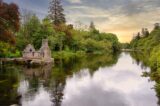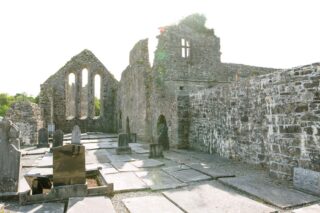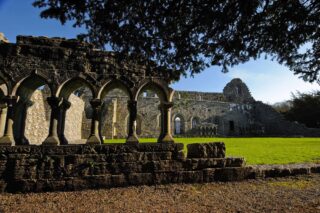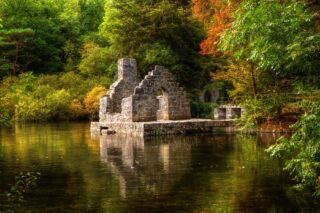Cong Augustinian Abbey and Monks Fishing House
An Abbey with associations to the High Kings of Ireland
Unguided sitesNotice
Cong Abbey is a state-owned National Monument in the care of the Office of Public Works
WARNING: It should be noted that these sites are unguided and a level of care and caution should be maintained during all stages of your visit. The Office Of Public Works (OPW) will not be held responsible for any damages, injuries, or losses that occur
Cong Augustinian Abbey and Monks Fishing House
Located near the River Cong, in the grounds of Ashford Castle, lie the remains of an Augustinian Abbey. Founded in the 12th century by Turlough O’Connor, King of Connaught, Cong Abbey is sitting on the site of an earlier monastery that was founded in the 7th century by St. Feichin.
The church is said to have burned down in 1114 and 1137. After the Dissolution of Monasteries in the 1530s the Abbey changed hands three times: first passed to the Binghams, then to the O’Donnell’s, and finally the Brownes. Different construction periods are evident on what remains today; the north and south walls and east gable of the church, and the north-east part of the cloister are all original, while the rest is mostly modern reconstruction.
It is said that Rory O’Connor, the last High King of Ireland, spent his remaining days at the Abbey.
About 90m west of the Abbey is a beautifully situated little stone building, known as the Monks Fishing House. Sitting on the Cong River, it has a small narrow opening in the floor to allow for fishing to take place, and the outlines of a fireplace in the west gable wall.
This now roofless structure was likely the oasis for the Monks of the Abbey.
Visit Historic Environment Viewer for more information on Cong Abbey & Monks Fishing House
Protect our Past - Click here to read about the importance of protecting our country’s unique heritage sites
This national monument is protected in accordance with the National Monuments Acts 1930 to 2014
Gallery
Nearby sites to visit
Aughnanure Castle
A historical gem in the heart of Connemara
Approx. 13.5 km from Cong Augustinian Abbey and Monks Fishing House
Ionad Cultúrtha an Phiarsaigh Conamara- Pearse’s Cottage and Visitor Centre
A cottage steeped in revolutionary history and Gaelic culture
Approx. 27.7 km from Cong Augustinian Abbey and Monks Fishing House
Athenry Castle
An emblem of Norman lordship
Approx. 44.8 km from Cong Augustinian Abbey and Monks Fishing House
Dún Aonghasa – Ancient Stone Fort
One of western Europe’s most magnificent stone forts
Approx. 56.0 km from Cong Augustinian Abbey and Monks Fishing House
Roscommon Castle-South West Tower
A dramatic and imposing thirteenth Century Norman Castle
Approx. 72.9 km from Cong Augustinian Abbey and Monks Fishing House
Rathcroghan Visitor Centre
Follow in the footsteps of Queen Medb at Connacht’s ancient capital
Approx. 73.1 km from Cong Augustinian Abbey and Monks Fishing House




